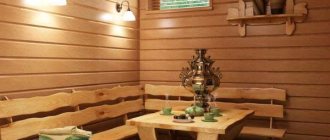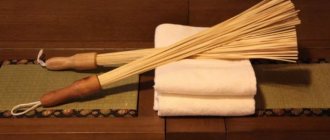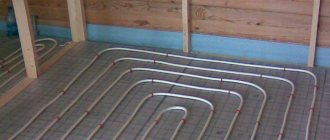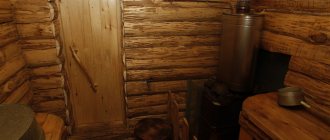Nowadays, a bathhouse is one of the mandatory holiday attributes for many Russians. Owners of summer cottages and residents of the private sector who have built a bathhouse on their site often encounter the phenomenon of condensation in the dressing room. Water drips from the ceiling, the walls get wet, mold and mildew form, which, in turn, harms not only the structure itself and the things stored there, but also human health.
Eliminating the cause of condensation in the dressing room in winter is not always easy due to its proximity to the wettest rooms. But this must be done as soon as possible.
What is condensate?
Condensation is the name given to moisture that settles on walls and ceilings due to temperature differences. Under the influence of heat from the stove, the water evaporates and is converted into steam, which, thanks to the circulation of air in the room, collects at the boundaries of the room. The walls, ceiling and windows are at the junction of two temperatures. On the one hand, this is the warmth of the interior, on the other, the cold from the street. The steam settles on the cooler surface, forming dampness.
A number of factors can influence the formation of moisture:
- Violations during thermal insulation work. A thermal insulator, for example, polystyrene foam, does not “breathe” simply because it does not allow steam to pass through it, which results in the formation of moisture. Sometimes the reason is the dew point, which is located not outside, but inside the room, causing the walls to become damp and wet. Recall that the dew point is the temperature at which steam turns into water.
- Violations during ventilation installation. The temperature in the steam room and dressing room varies significantly and when the doors are opened, steam settles in the room and flows down the walls.
- High humidity in the room. Water evaporates in the form of steam, collects near the walls and ceiling and forms condensation.
- High air temperature, especially in winter. The temperature in the bathhouse (dressing room) is always higher than the temperature outside, and in winter this value can be tens of degrees. Steam settles on a colder surface, windows sweat, and moisture collects on the walls and ceiling.
Why is condensation dangerous?
Dampness and high humidity, first of all, are a favorable environment for the development of various microorganisms, fungi, and mold. Wet walls and ceilings often lead to the formation of rot, which can cause the bathhouse to fall into disrepair. Just as mentioned above, all this can adversely affect human health.
How to eliminate the causes of condensation in the dressing room?
One of the easiest ways to remove condensation is to coat surfaces exposed to hot steam with heat-insulating paint. When the bath warms up, the upper part of the walls and ceiling will heat up faster, which will significantly reduce the amount of moisture formed on them. It is also necessary to insulate the room from the outside, moving the dew point closer to the outer layer of load-bearing walls.
If you're willing to spend a one-time investment, you can purchase a dehumidifier that will do all the work for you. It will eliminate excess humidity, which causes condensation, which means that the windows will no longer sweat, the walls will not get wet, and the ceiling will not drip.
Upgrading the ventilation system will help get rid of condensation in the dressing room in winter. One of the easiest ways is to create ventilation holes in the ceiling - strictly opposite each other at opposite ends of the room. This way, excess steam and humidity will escape from the room, and you won’t have to worry about drafts.
Low-power fans can be installed in ready-made ventilation holes to help cope with dampness. Do not forget that during procedures in the steam room, all ventilation holes must be closed with thick fabric or special valves until the end of the session.
It would also be a good idea to simply ventilate the room after use. Wet walls and ceilings can be wiped with a rag or mop and leave the door open until completely dry.
Many craftsmen advise installing vaults for water drainage. If you have a so-called leaky floor - gaps are left between the floorboards, then the vault is installed directly under the floor itself and should have a slope towards the drain hole.
In the case of floorboards tightly fitted to each other, the drain is installed in the lowest place. It is imperative to insulate the floor with waterproofing and periodically check its integrity. Craftsmen advise installing valves in the drain to prevent the appearance of an unpleasant odor.
The water from the drain must be discharged outside the building or the bathhouse itself must be built on a pile foundation so that the wood dries out better and the evaporating liquid does not condense in the bathhouse.
Installing heating devices in the dressing room also helps reduce humidity and eliminate condensation factors. A stove or fireplace heated with wood or heated by electricity will dry the air from steam and prevent condensation from forming.
Don't forget about safety precautions. Any heating devices must be installed strictly according to the rules, because their presence increases the risk of fire. Do not leave stoves and fireplaces unattended, extinguish the coals before leaving and turn off the power from the mains.
For more information on installing heating devices and ventilation in the dressing room, see below.
Options for getting rid of condensation
Scheme for insulating the walls of a bathhouse from the outside Formation of condensation in a pipe
Today, everyone with a bathhouse erected on their territory can afford to choose the most appropriate method of dealing with condensation in the room space.
Ventilation
If it is not possible to use more modern methods, then you should at least let fresh air into the bathhouse space. This is one of the ways to get rid of condensation in the dressing room in winter.
When the walls are exposed to cold on the street side, and summer temperatures reign inside the room, the level of condensation increases significantly.
It is clear that during your stay the windows will not be opened, because you can freeze and ruin the essence of the steam room.
Detailed diagram of the ventilation device in the bathhouse
Therefore, it is better to make the moment of relaxation habitual, and when everyone has left the bathhouse space, carry out the following procedures:
- Open the dressing room door.
- Wipe all surfaces thoroughly with a mop or cloth.
- Leave the door open until the moisture has completely left the room.
- Then you should again go over all surfaces with a dry cloth to eradicate sources of corrosion from the open spaces of the room.
Installation of fans
This is an ideal option that will help ventilate the space without unnecessary effort. Even the most primitive ventilation systems will help remove the moisture that has formed from the bathhouse, which will ensure normal air circulation in the room and get rid of condensation.
Ventilation hole in the dressing room
To ensure that the cost of financial resources does not exceed the norm, you can buy the most inexpensive ones. They will have to be changed periodically, but they will serve their time, performing their functionality efficiently.
Installation of a fan in a bathhouse
Diagram of the forced ventilation device in the dressing room
It is worth remembering that when visiting the steam room, the ventilation holes should be covered with thick fabric or special valves. After the end of the session, be sure to open the ventilation units to remove excess moisture. Watch the video to learn where mold and mildew come from in a bathhouse.
Proper thermal insulation and design of water outflows
Sometimes eliminating condensation becomes possible after installing proper thermal insulation and vaults for water drainage. Often, condensation occurs when water flows beneath the surface of a structure.
Accumulating in the liquid, it begins to evaporate, resulting in moisture appearing on the surfaces of the floor, ceiling, and walls. If the thermal insulation of walls, floors and ceilings is not done correctly, condensation may appear due to incorrect thermoregulation in the space. Drafts, blowing, cracks can negatively affect the overall atmosphere in the room.
Therefore, it is worth periodically checking for damage to the insulation material. If defects are found, the thermal insulation system should be corrected or reconstructed.
Bake
If possible, then such a solution will be ideal and the construction of the bathhouse will last for many years. A stove or fireplace heated with wood or electricity will help dry the air and eliminate factors that can cause increased condensation.
Drawing of a ventilation device using a sauna stove
It is worth remembering that if a stove is installed in the bathhouse, you should carefully ensure that safety precautions are observed at the proper level. After all, the presence of such devices increases the risk of ignition. Therefore, you should never forget to turn off the fireplace or put out the coals in the stove to avoid trouble.
Existing options for ventilation in the bathhouse
Condensation in the dressing room can play a cruel joke on private sector owners. Constant moisture on the walls, ceiling and floor can begin to destroy it from the inside, which entails enormous costs.
Therefore, it is worth approaching the issue of caring for the bathhouse with full responsibility. If you properly get rid of condensation, then it cannot harm your favorite place for intimate conversations, health procedures and just a pleasant pastime.
Eliminating the cause of condensation in the dressing room in winter is not always easy due to its proximity to the wettest rooms. But this must be done as soon as possible.
Nowadays, a bathhouse is one of the mandatory holiday attributes for many Russians. Owners of summer cottages and residents of the private sector who have built a bathhouse on their site often encounter the phenomenon of condensation in the dressing room. Water drips from the ceiling, the walls get wet, mold and mildew form, which, in turn, harms not only the structure itself and the things stored there, but also human health.
Eliminating the cause of condensation in the dressing room in winter is not always easy due to its proximity to the wettest rooms. But this must be done as soon as possible.
Condensation in the waiting room
Many people love to wash in a Russian bath. Why not build it on your country plot? But it’s one thing to build it, and quite another to take care of it. Many bathhouse owners are faced with the problem of high humidity, which settles on the walls and ceiling and leads to wood rotting and the formation of mold and mildew on the walls. Condensation flows down the walls without drying completely, and this causes irreparable damage to building structures.
What is condensate?
During the cold season, low outside temperatures help to cool external windows and walls, as well as lower the temperature of the heated air in the room itself. When this happens, moisture begins to condense in the air, which flows down the windows and begins to be absorbed into the cladding materials of the building. In the winter season, the situation worsens due to the fact that fresh air cannot replace humid air and therefore a process called condensation is repeated again and again. Very often, finding out the main cause of condensation can be very difficult, and sometimes completely impossible. The influence is exerted by many factors, including:
Is condensation dependent on ventilation?
Condensation on the walls in the dressing room is a consequence of improper installation of ventilation. It is known that in the washing room and steam room the air temperature is much higher than in the dressing room. When people leave the steam room, all the steam goes into the room and settles on the walls, flowing down in streams. All this happens due to temperature changes. After a certain period of time, the bottom boards have to be replaced, as they begin to rot, become overgrown with fungus, and an unpleasant musty smell appears. It is necessary that the room has a window with a window, in addition to the main ventilation, this will make it easier to dry the walls and reduce condensation.
A new bathhouse requires new technologies!
When building a new bathhouse, new technologies can be used. The wooden lining inside can be treated with special antiseptics that do not emit harmful fumes. You can also impregnate the wood with the antiseptic composition “Senezh Ecobio” before construction, protecting the deep layers of wood. After this, treat with a special protective coating “Senezh Sauna”, it has increased moisture resistance and an antimicrobial effect. At the same time, there is no need to paint, varnish, or dry wood structures. It is recommended to lay ceramic tiles on the floor, which are not susceptible to rotting and mold and will last a very long time. If, when building a bathhouse, you properly install ventilation and treat the wood with modern materials, then these actions can minimize the release of condensation on the walls and floor, which will lead to long-term operation. Take care of your health!
[content-egg module=GdeSlon template=compare]
A new bathhouse requires new technologies!
Condensation in the bath: possible causes
Condensation on the ceiling is a fairly typical phenomenon for any cold room, be it a bathhouse or a garage or underground.
We suggest you familiarize yourself with: Warm floor in a bathhouse with your own hands, water
If warm or even hot air enters a cold room, then, naturally, upon contact with a cold surface, the warm air turns into water and settles on the same cold surface.
If you haven’t heated the sauna all week, and it’s frosty outside, then when you flood the sauna stove, all the warm air will rush to the ceiling and “settle” on it as condensation. If you go into the bathhouse after a couple of hours, you will see that there is less condensation, because in 2 hours of heating the walls, floor and ceiling (the entire room) have warmed up and dried to some extent.
You've probably noticed that when you come to your dacha in the spring, everything in the house, including clothes, mattresses and linen, is damp. The same goes for building structures, be it a house or a bathhouse. In the spring, they need to be warmed up for 3-5 days so that the humidity and cold coming from the walls and floor are no longer felt.
If in winter you heat a bathhouse once a week, on weekends, then you need to come on Saturday, heat it all day to dry, and then on Sunday steam and wash in a normal, dried bathhouse. By the way, that’s what all the villagers do: they heat the bathhouse for the day before bath Saturday or Sunday.
With this heating of the bathhouse, condensation will first form not only on the ceiling, but also on the upper logs. In winter, it is more correct to heat the stove moderately, adding firewood very little at a time, so that there is no huge emission of very hot air from the stove, so that the heating of the structures occurs more gently and gradually.
It happens that condensation in the bathhouse forms only on the ceiling, even when the bathhouse was heated the day before. Since only the ceiling is cold, this means the reason is the insufficient layer of insulation in the ceiling.
If the insulation was done with modern materials such as mats or slabs made of basalt fiber or mineral wool, then for a residential building a thickness of 150 mm is needed, and for a bathhouse, in which the room temperature is much higher, the thickness of the insulation should be 200 mm.
A ceiling can be cold if there is no vapor barrier layer, which must be laid before laying insulation made of mineral wool or glass or basalt fiber. Over time, your insulation will pick up moisture and lose all its thermal insulation qualities. You think that you have 200mm of good insulation there (on the ceiling), but there has been nothing there for a long time.
When expanded clay is used as insulation in a bathhouse, the ceiling will also be cold:
- Expanded clay in its thermal properties is inferior to basalt slabs several times and, accordingly, its thickness should be much greater: no longer 200 mm, but 600. So, mineral wool insulation has a thermal conductivity coefficient of 0.045 W/m*k, and expanded clay = 0.15, that is, 3.34 times more, which is 3 times worse for the ceiling of a bathhouse.
- Expanded clay has a fractional nature and the larger the fraction, the more voids there are between the expanded clay pebbles. That is, there is no dense insulation. For insulation it is necessary to use expanded clay of a minimum fraction of 5-10mm.
To make sure that a large (600 mm) thickness of the insulation layer is needed from expanded clay, simply make a thermal calculation taking into account the average winter temperature for your region (let it be -20 C) and the internal air in the bathhouse premises.
Another case is when condensation in the bath is on the ceiling of the rest room and only here. In the steam room and washing room - no. Again, in the winter, visit the bathhouse.
The fact is that in the steam room it is 100 degrees, in the washing room it is 50 degrees, and in the relaxation room it is 10 degrees. Naturally, of all the rooms, the rest room is the coldest. To avoid condensation in the bathhouse on the ceiling of the rest room, there is only one way out: in winter, additionally heat the rest room (dressing room) with some kind of electric heater (heater) to reduce the temperature difference between the rooms.
You can specifically warm up the ceiling of the rest room (dressing room) with some kind of wall heater with a directed air flow. While the bathhouse is heating, such a heater will have time to warm up and dry the ceiling of the rest room.
Usually there is no such problem if a five-walled bathhouse with a steam room and a relaxation room, that is, consists of two rooms located in one log house. Moreover, the sauna stove is heated from the relaxation room. In such a bath, heating of the structures occurs evenly. Accordingly, if there is no cold surface, then there is no condensation in the bath.
Constant condensation in the bathhouse leads to rotting of the wood and an unpleasant odor from mold and mildew. Therefore, when using a bathhouse not only in summer, but also in winter, you need to consider measures for ventilation and drying of rooms and structures.
If in summer to dry the bath it is enough to open all the windows, doors and lift the floor boards, then in winter you cannot open the door. And during a week of no heating, all wooden surfaces that remain wet will not dry out, but will freeze.
We invite you to read: Which doors to choose for baths and saunas: selection and installation rules
In winter, it makes sense to do a special heating of the bath the next day, with which you can dry those surfaces that were wet after the bath day:
- cold surfaces in the bathhouse can be not only ceilings, but also windows, if their design is of a summer version (with one glass and framed from 50mm bars)
- in a small bathhouse, in the absence of a ventilation system, usually the doors are opened for ventilation and then above the doors (the ceiling and the ceiling around the door) will be wet from condensation (from the collision of warm air with the outside cold air admitted through the door)
The reasons for the appearance of condensation in a bathhouse are different. And in each specific case, you need to find it, then somehow solve the problem so that your bathhouse lasts longer.
[content-egg module=GdeSlon template=compare]
When building a new bathhouse, new technologies can be used. The wooden lining inside can be treated with special antiseptics that do not emit harmful fumes. You can also impregnate the wood with the antiseptic composition “Senezh Ecobio” before construction, protecting the deep layers of wood. After this, treat with a special protective coating “Senezh Sauna”, it has increased moisture resistance and an antimicrobial effect.
At the same time, there is no need to paint, varnish, or dry wood structures. It is recommended to lay ceramic tiles on the floor, which are not susceptible to rotting and mold and will last a very long time. If, when building a bathhouse, you properly install ventilation and treat the wood with modern materials, then these actions can minimize the release of condensation on the walls and floor, which will lead to long-term operation. Take care of your health!
Why does condensation occur in the dressing room and how to get rid of it?
Why does condensation form in the dressing room? This question worries many. Any Russian bathhouse has a room called a dressing room. In it, as a rule, people relax after the steam room, store things, other various attributes and a small fuel reserve for the stove. However, very often the condensation that forms on the walls and ceiling in the dressing room becomes a huge problem, since it is not easy to get rid of it due to the fact that the dressing room directly communicates with the “wettest” rooms.
Building a bathhouse on your country property is one thing, but proper care of it is something completely different. The problem of high humidity with the formation of condensation, which settles on the surface of the walls and ceiling of the bathhouse, leads to the appearance of mold and mildew on them, and wet walls from excess moisture are susceptible to very rapid destruction of building structures and rotting of wooden parts.
It is rare that a stove is installed in the dressing room, which simultaneously performs the function of heating the room and providing natural ventilation through it. In all other options, to get rid of condensation in the dressing room, the most optimal and convenient methods of ventilating the bath should be provided.
Reasons for the formation of condensation in the dressing room
When there is a low minus temperature outside, which cools the outside walls and windows of the bathhouse building, and inside this building the air is usually somewhat warmer, then condensation forms on the entire surface from the inside. Excess moisture accumulates, and since in the cold season drops of water simply do not have time to evaporate from the surface, then it begins to slowly be absorbed into the facing material of the building and thereby destroy it.
Due to the constant temperature change, after a certain period of time, the owner of the bathhouse most often has to replace the bottom boards in the floor, which begin to rot, become overgrown with fungus and emit an unpleasant odor, with new ones.
Why does condensation collect in the dressing room? There are several reasons influencing this process:
- high humidity;
- improperly performed thermal insulation;
- high air temperature;
- poor ventilation.
Advice from the master!
It is often very difficult, and sometimes completely unrealistic, to identify the main root cause of condensation in the dressing room. However, in order to reduce the content and accumulation of moisture in the bathhouse, and especially in the dressing room after taking water procedures, it is recommended to install an exhaust ventilation system and provide a small window with a window in the room in order to additionally naturally dry the walls in the dressing room and thereby reduce the formation drops of water on their surface.
Is condensation dependent on ventilation?
Condensation on the walls in the dressing room is a consequence of improper installation of ventilation. It is known that in the washing room and steam room the air temperature is much higher than in the dressing room. When people leave the steam room, all the steam goes into the room and settles on the walls, flowing down in streams. All this happens due to temperature changes. After a certain period of time, the bottom boards have to be replaced, as they begin to rot, become overgrown with fungus, and an unpleasant musty smell appears. It is necessary that the room has a window with a window, in addition to the main ventilation, this will make it easier to dry the walls and reduce condensation.
Schemes and types of ventilation in the bathhouse
Russian bathhouse - what could be better? If earlier there was a tradition of going there on holidays, now many are trying to build it on their site or near a country house. But along with the opportunity to take a steam bath at any time, problems also arise. Now you need to know everything about everything and take care of the bathhouse yourself.
Fresh air should freely enter the room, and exhaust air should exit back. There are several ways to move air in a bathhouse:
- Forced ventilation in the bathhouse. To create an outflow and inflow of air masses, specialized technical means are used that completely control the process.
- Natural air draft. Such traction is possible not only on the basis of simple dampers and holes in the walls. For natural ventilation of the bath room, it is necessary to manufacture ventilation vents or construct a bath complex from specialized breathable materials.
- Combined method. This method means the simultaneous use of natural ventilation in the bathhouse and a forced device for the movement of air masses. The simplest ventilation device in a bathhouse is a fan and open valves on the ventilation ducts.
The correct microclimate in the bathhouse is the correct operation of the ventilation system, which allows you to regulate: air humidity, thermoregulation and air circulation. The ventilation design schemes for bath complexes have a number of features:
- The exhaust hole should be located several tens of centimeters higher than where you plan to install the supply air. This will allow air to circulate properly, since cold air is much heavier than hot air.
- The ventilation valve must not be installed on the ceiling. The ceiling warms up more slowly, unlike other surfaces in the room.
- The correct location of air supply fans is near the stove or a few centimeters from the floor.
- Proper ventilation in a bathhouse meets the following principles: exhaust openings must be located on the other side of the room from the supply openings; Valves must be installed in the hood openings.
After visiting the steam room, you need to take a break from the heat for some time, so the bathhouse needs a room that will meet such functionality. The rest room must be ventilated. The equipment for ventilation of the rest room does not differ from similar ventilated systems in other functional rooms.
After visiting the steam room, you must rest in a special room, which must also be equipped with a ventilation system
If the room is small and there is no access to water, then a natural ventilation system is best suited. Several times a day it is necessary to create a draft in the room.
If the rest room is combined with a washing room, then to eliminate dampness it is necessary to use a combined room ventilation system with vents in the floor. The pipes of such an vent must go up the structure.
Rules for caring for bath premises
Most of these problems can be avoided.
Pine and spruce lumber must be of ideal quality, without a single knot, because basically they are the gateway for the released resin.
Boards with cracks, knots and blue stains are not suitable for a bathhouse.
The material must first be steamed and dried, then the release of resin will be reduced to a minimum.
Pine boards should be selected with almost no defects
You need to carefully inspect all lumber you purchase. A tree affected by fungus or rotten is immediately visible. If you notice specimens that are black or blue, it would be advisable to contact another supplier. There is a high probability that the entire batch is affected, even if the fungus is not noticeable on all the boards and logs.
It is better to buy wood cut down in winter. Frost will prevent fungus from spreading in the wood. And before use and after assembly, wooden elements must be treated with antifungal impregnation.
Fungus on a log cut is immediately visible
Application of impregnations
This remedy can protect you from many problems associated with the operation of the bathhouse. For a modern busy person who does not want to use impregnation, there are only two ways to avoid the appearance of dirt:
- rarely use the bathhouse or allow a small number of people into it (and dry it well each time);
- every two to three years, completely change the furniture, lining on the ceiling and walls (but this method is not suitable for everyone).
Fans of a healthy lifestyle claim that treating wooden surfaces inside a bathhouse is not only unnecessary, but also harmful. They believe that impregnation and paint coatings, when heated, give off a strong chemical odor and emit harmful volatile substances. This is true if you use ordinary products not intended for use in a bathhouse. But if you leave the tree in its original form, it cracks, and fungus multiplies in the cracks and micropores.
Domestic (Senezh, Neomid, Belinka, Aquacolor, Empils, Rogneda) and foreign (Dulux, Tikkurila, Nobel, Belinka, Teknos) manufacturers of varnishes and paints produce many products for interior and exterior impregnation.
Ventilation in the steam room
| How ventilation works | Features of the system | Is the ventilation system suitable for a bathhouse? |
| Natural | With natural ventilation, convection is formed due to the pressure difference between the bathhouse and the street. Any location of the supply vent, as well as the exhaust vent, will interfere with proper heating of the steam room. | No |
| Combined | This method is the most optimal due to the lack of strict rules for the placement of fans. Devices for forced ventilation in the steam room are installed in any of the ways convenient for the builder. | Yes |
| Mechanical | This method is the most expensive, and not every builder can afford it. The supply of fresh air and temperature in the bathhouse is maintained by a specialized device. This type is also suitable for baths that are installed inside country houses. | Yes |
Correct installation of ventilation according to the type of room
No matter what type of bath complex is chosen for construction, high-quality installation of the air ventilation system is what is truly important. In a bathhouse made of foam blocks, a log house or a frame steam room, it is necessary to install only a combined or mechanical type of ventilation, since natural ventilation does not guarantee the safety and durability of the structure.
The combined type is also suitable for those pairs that are located directly in the house, and not in a separate room. There are several standard schemes for organizing the inflow and outflow of air, depending on the type of steam room.
Combined type of ventilation is an ideal choice for steam rooms located directly in the house
Bastu type ventilation
Most often, sauna lovers choose a Swedish type of construction for their steam rooms, called bastu. In such convection steam rooms, clean air is taken from the street, and it is also discharged to the street. The exhaust duct is installed under or next to the stove, and a damper is installed on the duct itself.
The box is installed at least thirty centimeters from the floor, and a pipe is led up the wall, which goes into a through hole right under the ceiling. A valve with a damper is also installed on the ventilation hole. Air intake equipment is installed on the wall opposite the furnace. It is best to choose an air intake box made of wood.
Ventilation of the steam room according to the bastu type is carried out according to the following scheme:
- Cool, clean air from the street circulates along the stove from the intake duct, heats up and rises.
- As the stove heats up, warm air masses near the ceiling begin to gradually put pressure on the cold air at the bottom of the room and gradually warm up the walls of the steam room.
- Hot air masses press against cold air and gradually, increasing pressure forces hot air out into the vents.
The popularity of this type of baths is high due to the comfortable conditions inside the steam room. And the undoubted advantage is the ability to install the bastu at home, in any convenient place. There are even apartments equipped with baths according to this principle.
Organization of ventilation in a frame bath
The principle that must be followed if you start building a bathhouse is to ensure air circulation and avoid stagnation. A supply and exhaust ventilation system is the most suitable option for a frame bath. It will allow clean air to move freely throughout all rooms of the bath complex, and will effectively remove polluted air outside.
Supply and exhaust ventilation is ideal for frame baths.
For proper operation of the system, two air channels are required.
Using the first channel, clean air enters the steam room, and the second ensures effective removal of heated air. The first channel must be placed almost flush with the floor, when the second is placed right at the ceiling. This difference in hole placement provides effective traction. Small dampers need to be installed in the holes, this will allow you to control the movement of air masses. The basic scheme for constructing ventilation for a frame room includes: channels for pipes, pipes from the stove, dampers, doors, through holes. In a frame wooden bathhouse, the principle of a supply and exhaust system is relevant only in the case when at least one wall has a connection with the street.
How to eliminate the causes of condensation in the dressing room?
When there is a low minus temperature outside, which cools the outside walls and windows of the building - baths, and inside this building the air is usually somewhat warmer, then condensation forms on the entire surface from the inside. Excess moisture accumulates, and since in cold times years, drops of water simply do not have time to evaporate from the surface, then it begins to slowly be absorbed into the facing material of the building and thereby destroy it.
Due to the constant temperature change, after a certain period of time, the owner of the bathhouse most often has to replace the bottom boards in the floor, which begin to rot, become overgrown with fungus and emit an unpleasant odor, with new ones.
Why does condensation collect in the dressing room? There are several reasons influencing this process:
- high humidity;
- improperly performed thermal insulation;
- high air temperature;
- poor ventilation.
One of the easiest ways to remove condensation is to coat surfaces exposed to hot steam with heat-insulating paint. When the bath warms up, the upper part of the walls and ceiling will heat up faster, which will significantly reduce the amount of moisture formed on them. It is also necessary to insulate the room from the outside, moving the dew point closer to the outer layer of load-bearing walls.
If you're willing to spend a one-time investment, you can purchase a dehumidifier that will do all the work for you. It will eliminate excess humidity, which causes condensation, which means that the windows will no longer sweat, the walls will not get wet, and the ceiling will not drip.











